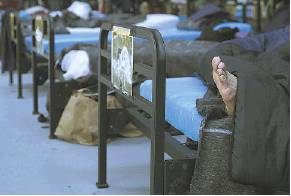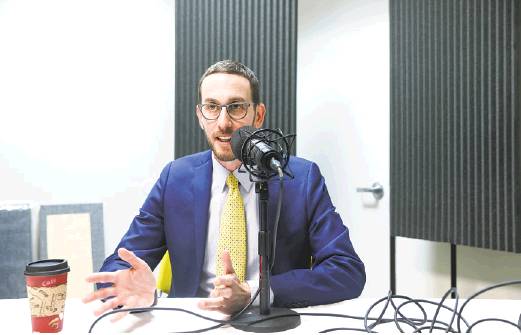On San Francisco
As 1,267 people wait for beds, a solution?
By Heather KnightHEATHER KNIGHT
On Monday afternoon, San Francisco’s notoriously long waiting list for a shelter bed numbered 1,267 people. You can see the ever-changing list online and also each homeless individual’s chances of sleeping in a bed that night.
You won’t see anybody’s name or much about them, but you can see the client identification number the city uses to track them, and their birth date.
There are surely 1,267 sad stories on that waiting list. The saddest to me was No. 20 in the line — born on Aug. 30, 1930, when Herbert Hoover was president and there were just 48 states.
Yes, there was somebody 88 years old waiting for a shelter bed in San Francisco on Monday.
Such a list of human misery wouldn’t exist anymore in California —or at least wouldn’t be nearly so long — under a new proposal from state Sen. Scott Wiener.
He wants homeless people throughout the state to have a “right to shelter,” meaning any homeless person in any county could receive a shelter bed. No more months-long waiting lists. No more counties getting away with providing far too few shelter beds or offering them only during the cold winter months.
It’s a big idea. And one that’s not even close to fully baked, as Wiener readily admits.
He doesn’t know exactly how it will work. He doesn’t know how much it will cost or how it will be funded. He doesn’t want it to be the same as New York City’s controversial right-to-shelter program, but he can’t say how it will be different.
The proposal is merely a placeholder while Wiener begins talks with homeless advocates, city leaders and others. It comes two months after Mayor London Breed announced a plan to create 1,000 more shelter beds by 2020. Currently, the city has 2,500.
Wiener’s proposal might not be ready for a vote until next year, but it’s worth talking about now because he is the kind of middle-of-the-road, practical politician who could make it a reality. Coming from him, this is automatically a serious proposal and not just a pie-in-the-sky idea.
But mostly, it’s worth talking about because the state’s homeless crisis shouldn’t be shouldered by just the cities and counties willing to do the work and spend the money. There should be far more collaboration, and there should be far more guidance and funding from Sacramento.
“We have a huge and growing homeless population in California, and it’s no longer just in places like San Francisco, Berkeley and Los Angeles,” Wiener said. “We want to look at how we can have better geographic equity, so people have access to shelter no matter where they are in the state.”
Right-to-shelter laws exist in just a few municipalities around the country. By far the best known is New York City’s program, which was mandated by court order following a lawsuit in 1979 by a homeless man, Robert Callahan. Though his lawsuit forced the city to create shelter beds for the homeless, he died living on the streets before it went into effect in 1981.
There are good points and bad points to New York City’s law. The good? It provides beds to more than 60,000 homeless people in the city each year. Those who, for one reason or another, aren’t in shelter numbered 3,675 in the last one-night count.
That’s in a city measuring 303 square miles and with 8.6 million residents. In our comparatively tiny town — with 47 square miles and 885,000 residents — there were 4,353 unsheltered homeless people in the last one-night count. And 7,499 homeless people overall.
That means New York City’s homeless people are far more likely to sleep in a bed inside than San Francisco’s homeless are. And those on the streets in New York City are far less in-your-face, since there are fewer of them and they’re spread out over so much more space.
The bad parts of New York’s plan? The patchwork system, which includes some private apartments and commercial hotel rooms rented by the city to meet its legal obligations, has been slammed as offering seedy and ramshackle facilities and merely warehousing people rather than trying to move them into better lives.
New York City spends $1.6 billion annually on shelter, with little left over for quality social services and permanent supportive housing.
San Francisco’s Department of Homelessness and Supportive Housing spends most of its money on the supportive housing part, and every month homeless people are moved inside. The problem is there’s too little left over for quality shelters, and too many people are stuck sleeping under cardboard or in tents.
Perhaps Wiener can figure out a way to strike a balance. He envisions Navigation Centers — the more-welcoming versions of homeless shelters, with on-site case managers — up and down the state. And, yes, he acknowledges that would cost a lot.
I asked him why he’s introducing this weeks after coming out against Proposition C, the San Francisco ballot measure that passed last month and, barring lawsuits, will tax the city’s biggest businesses to raise an additional $300 million for homeless services including shelters.
“Money by itself doesn’t solve the problem,” he said. “Prop. C was not a new plan. It was doubling what we spend on an existing plan.”
It seems that the right-to-shelter idea is so new, so big and so vague that a lot of people who would be key to its implementation aren’t willing to talk. Requests for comment from Mayor Breed; her homeless chief, Jeff Kositsky; and Gov.-elect Gavin Newsom didn’t get responses by deadline.
The moderate Wiener does, however, have some early support among the most progressive members of the Board of Supervisors.
Supervisor Hillary Ronen, who has fought to place new Navigation Centers in the Mission, called the idea “fantastic.” City officials across the political spectrum are abandoning the idea pushed by then-Mayor Newsom of ending shelter in favor of only permanent, supportive housing. They rightly say that’s not realistic.
“We can’t just have people languishing and dying in the streets as we wait decades to build enough affordable housing for everyone,” Ronen said. “We need a safe, dignified place for people to be in the interim.”
Supervisor Rafael Mandelman said the most important part of Wiener’s idea is making homelessness a statewide conversation.
“Elevating this up above our internal San Francisco food fight is certainly good,” he said.
Stay tuned, readers. As Wiener says, this is only the beginning.
San Francisco Chronicle columnist Heather Knight appears Sundays and Tuesdays. Email: hknight@sfchronicle.com Twitter: @hknightsf



